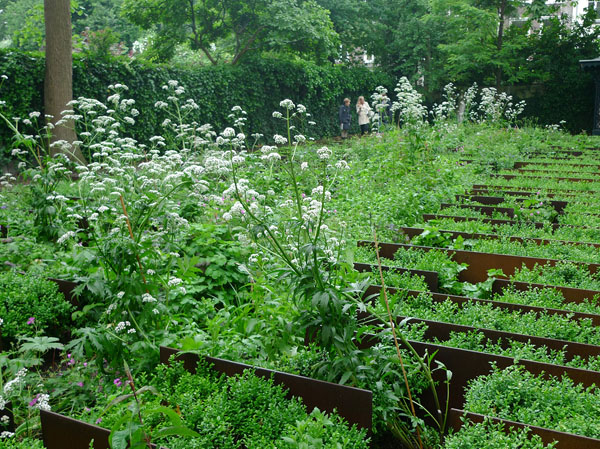
Last weekend Naomi and I hopped on the Eurostar for a garden nerds’ getaway. We went to Amsterdam for its open garden weekend (Open Tuinen Dagen), when around 30 gardens open to the public. There aren’t many people I could drag around 30 gardens, but Naomi is definitely one of them.
We managed to see around 25 of the gardens in two days, and it was fun. We got to snoop at some pretty impressive canal houses, galleries and museums (the Dutch seem shamelessly nosy, so we were too). We discovered streets we wouldn’t normally have walked down, stopped off in some nice cafes, and in true garden visiting tradition, ate a lot of cake.
Box is most definitely the dominant plant in Amsterdam, and many gardens, such as the one at the Museum Van Loon (above), are formal parterres. They’re found in even the smallest of gardens, filled with roses and bedding. They’re lovely, and a novelty at first, but we were soon hankering to see anything that wasn’t a box ball, hedge or block.
Fortunately around half of the gardens were virtually box-free. All of them had a design idea or planting combination to take inspiration from. Here are my favourites.

The garden at the swanky Canal House Hotel on Keizersgracht was designed by a couple of Brits, Rose Dale and Laura Heybrook of Dale and Heybrook. The contemporary black and white theme matched the interior of the hotel perfectly, and the abundant, lush planting and gentle water features made it a peaceful retreat. The hotel is pretty posh, but the staff were more than happy to let everyone lounge on the outdoor sofas, drinking free iced tea.

The garden at Amnesty Internation HQ (above) was a tranquil, contemplative space: a canopy of robinia trees underplanted with Luzula nivea and campanulas.

My prize for the most original garden went to the Canal House on Herengracht (above). In a bold take on the traditional parterre, oodles of box were confined within a grid of corten steel. The effect was loosened by blowsy, cow parsley-esque valerian (Valeriana officinalis).

The garden at Kerkstraat 67 was extraordinary. Huge hedges of perfectly sculpted privet swept down the garden and pooled at the bottom in big fat blobs.

The private garden above was delightfully romantic and pretty, and a great lesson in how to break up a square space.

And my favourite? The garden at La Cuisine Française. It didn’t have the wow factor of some of the other gardens, but it felt the most loved and lived in.
Its layout could be adapted to any long, thin garden and the planting was a happy mix of edible and ornamental – towering herbs including lovage and sweet cicely, standard gooseberries and wisteria, foxgloves, tons of salad and alliums – plus a huge dining table. Its English owner, Patricia, was on hand with plant advice and Dutch poffertjes. Many Amsterdam gardens have a garden house, and Patricia lives in hers.



